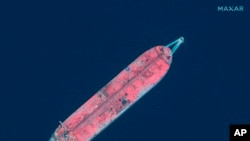A United Nations' pledging conference raised $33 million on Wednesday, far short of funds needed for a salvage operation of a decaying tanker full of oil moored off the coast of Yemen, a ship whose demise could cause an environmental disaster.
The U.N. had originally sought $144 million — including $80 million to transfer the more than 1 million barrels of crude oil onboard the FSO Safer to storage within the next four months. The first phase of the salvage was planned to be completed by the end of September, otherwise the vessel could face turbulent winds that start in October, according to the U.N.
The U.N. said it now has a total of $40 million, including previously committed funds for the operation. The tanker has been moored off the Red Sea port of Ras Issa since the late 1980s. The port, on Yemen's western coast, is controlled by the Iranian-backed rebels.
"We need to work quickly to get the remaining funds to start the four-month operation in the weather window we have ahead of us," said David Gressly, the U.N. humanitarian coordinator for Yemen.
Wednesday's pledging conference, co-hosed by the U.N. and the Netherlands, came more than two months after the U.N. and the Houthi reached an agreement to transfer the tanker's contents to another vessel. The agreement also includes a U.N. commitment to provide within 18 months a "replacement equivalent to the FSO Safer suitable for export."
The Houthis on Tuesday criticized the U.N. for allegedly "not presenting an operational plan" to maintain the tanker, more than two months since they signed the memorandum of understanding, a statement that could complicate U.N. efforts to raise funds.
U.N. deputy spokesman Farhan Haq, however, said they have been proceeding according to an agreed-upon plan. He said the U.N. was trying to urgently offload the oil "before the FSO Safer tanker breaks up."
The pledges Wednesday all came from European countries and the wealthy Gulf nation of Qatar. Saudi Arabia and the United Arab Emirates, which lead a military coalition fighting the Houthis, did not announce pledges during the event.
Gressly, the humanitarian coordinator, said this week the vessel is slowly rusting and going into significant decay, and could explode, causing massive environmental damage to Red Sea marine life, desalination factories and international shipping routes.
The U.N. estimates that about $20 billion would be needed to just clean up an oil spill, which would likely impact nearby countries, including Saudi Arabia, Djibouti and Eritrea, he said.
"The timing and funding are both critical," said Auke Lootsma, the U.N. Development Program's representative in Yemen, adding that bad weather in the winter could complicate the salvage operation and increases the risk of the ship breaking up.
The Japanese-built tanker was sold to the Yemeni government in the 1980s to store up to 3 million barrels of export oil pumped from fields of Marib province, currently a battlefield. The ship is 360 meters (1,181 feet) long with 34 storage tanks.
Since 2015, annual maintenance on the ship has come to a complete halt. Most crew members, except for 10 people, were pulled off the vessel after the Saudi-led coalition entered Yemen's civil war in 2015 on the side of the internationally recognized government.
Yemen's conflict started in 2014 when the Houthis took control of the capital and much of the country's north, forcing the government to flee to the south, then to Saudi Arabia.
Internal documents obtained by The Associated Press in 2020 show that seawater has entered the engine compartment of the tanker, causing damage to pipes and increasing the risk of sinking. Rust has covered parts of the tanker and the inert gas that prevents the tanks from gathering inflammable gases, has leaked out. Experts say maintenance is no longer possible because the damage to the ship is irreversible, according to an AP report.
The U.N. has repeatedly warned that the tanker could release four times more oil than the notorious Exxon Valdez disaster off Alaska in 1989.





